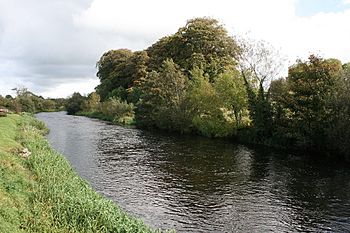River Inny (Leinster) facts for kids
Quick facts for kids River Inny |
|
|---|---|

River Inny, Ballymahon
|
|
| Native name | An Eithne |
| Country | Ireland |
| Physical characteristics | |
| Main source | Near Oldcastle and Loughcrew, County Meath |
| River mouth | Lough Ree (River Shannon) |
| Length | 88.5 kilometres (55.0 mi) |
| Basin features | |
| River system | River Shannon |
| Basin size | 1,254 km2 (484 sq mi) |
The River Inny (which is An Eithne in Irish) is an important river in Ireland. It flows into the River Shannon, which is one of Ireland's longest rivers. The River Inny is about 88.5 kilometres (55.0 mi) long and passes through several lakes on its journey.
Contents
What's in a Name? The River Inny's Story
The name of the River Inny comes from an old Irish legend. It is named after a mythical figure called Ethniu or Eithne. Stories say that Eithne passed away in the fast-moving waters of the river.
Where Does the River Inny Start and Go?
The River Inny begins as a small stream in a hilly area called Slieve na Calliagh. This is near Oldcastle in County Meath. This area is famous for its ancient stone tombs, known as Loughcrew.
The Upper Inny: From Hills to Lakes
In its early part, the river forms a border between County Meath and County Cavan. It then flows into Lough Sheelin. This lake is special because it touches three counties: Cavan, Meath, and Westmeath. This first part of the river is sometimes called the Upper Inny or the Ross River.
Rivers Joining Lough Sheelin
Many smaller streams and rivers flow into Lough Sheelin. These include the Mountnugent River, the Bellsgrove Stream, and the Crover Stream. Other streams like the Mauraghboy, Carrick, Rusheen, Moneybeg, and Schoolhouse also join here. The Upper Inny and Lough Sheelin are mostly on limestone rock. Some of the streams flowing into the lake cross over a harder rock called quartzite.
The Lower Inny: Through More Lakes and Towns
After Lough Sheelin, the river is often called the Lower Inny. It continues to form a border, this time between Westmeath and Cavan. It flows under a bridge at the village of Finea.
Journey to Lough Derravaragh
The Inny then enters Lough Kinale, where counties Cavan, Westmeath, and County Longford meet. From there, it mostly forms the border between Longford and Westmeath. It eventually flows into Lough Derravaragh. This lake is famous in Irish legends as the place where the Children of Lir were turned into swans.
Passing Through Towns and Canals
The river then flows near the village of Ballinalack and forms another lake called Lough Iron. It crosses into County Longford near Abbeyshrule. Here, a special bridge called the Whitworth Aqueduct carries the Royal Canal over the river. Water from the Inny is pumped to supply the canal.
Near a place called Tenelick, the river's fast-moving water once powered two mills. This is also where the mythological Princess Eithne is said to have passed away, giving her name to the river. The Inny then flows past Newcastle House and reaches the town of Ballymahon.
The End of the Journey: Into the Shannon
Downstream from Ballymahon, the River Inny once again marks the border between Longford and Westmeath. It flows westwards and finally empties into Lough Ree at a place called Inny Bay. Lough Ree is a large lake that is part of the River Shannon system. The Shannon eventually flows into the Atlantic Ocean.
Changes to the River Over Time
In the 1960s, some work was done to drain parts of the river. This removed a small dam (called a weir) at Newcastle. This weir used to help power a generator and a sawmill for a large house nearby. The draining also closed off the millrace and millpond that fed a ruined mill at the bridge in Ballymahon. This meant the sound of the waterfall at the mill, which had been roaring for about 100 years, became quiet.

